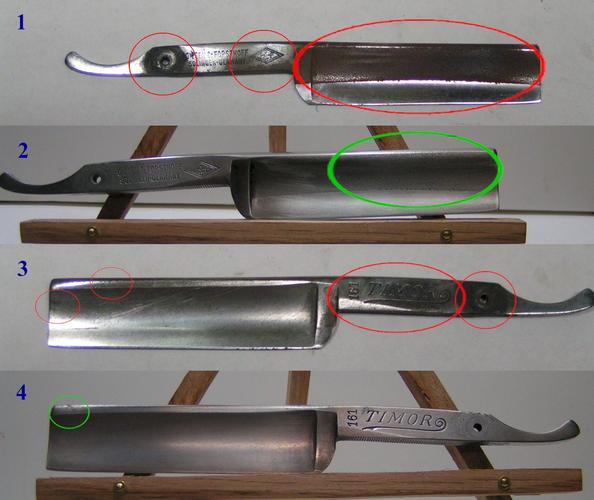Results 61 to 70 of 74
Thread: electrolysis for rusty razor
-
10-04-2012, 11:14 PM #61

Tom, you are correct, this whole experiment is about restoring a blade with the minimum, if any, metal removal. The very first blade I posted used only the electrolytic process and a tumbler with "polishing" compound, not rubbing compound. Total amount of metal removed was: NONE! I have concluded the electrolysis method is worthwhile for no other reason than to see if you have to go further. I recently tried the process on a W&B Extra Hollow Ground you sent me. Since I am no longer really documenting simple brown rust removal, I was amazed at the results. I have no before picture good enough to post but maybe you can attest the etching was nearly unreadable and there was significant rust above and over the etching. This is how it turned out with less than an hour in the vat. It may have been done sooner than that but I was working on something else and just let it go. Here is the picture:
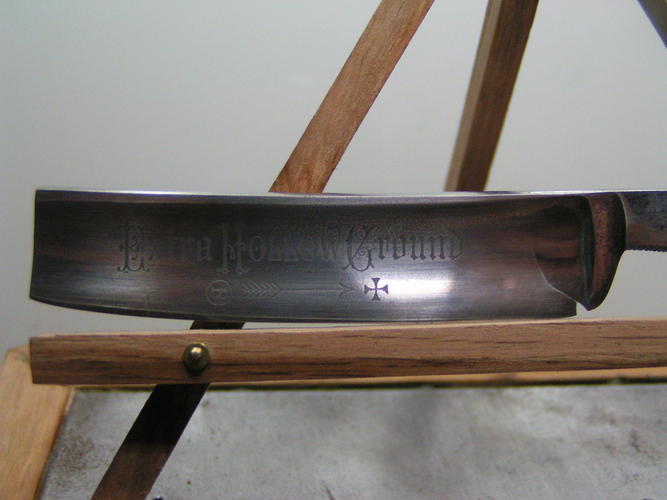
If the blade were not cracked, it would take very little effort and metal removal to restore it to good condition.
I know nothing at all about buffing so this question may be stupid (when did that ever stop me?) but: If you can remove all the brown rust with just a few minutes of electrolysis, would it not only give you a better idea of just how much work is needed but also keep all that rust from gunking up your compound and thus extending its usefulness?
Like the above picture, the one posted earlier that took only 15 minutes in the vat and the original blade that started this whole thing, you never know if you need to start removing steel until you see what you have from this process. Sometimes, electrolysis is all you need other than light sanding and polishing.
My two cents and you can do with it what you may. I just think this process has a place in blade restoration and I am intent on proving it.
Randy“Tell me and I forget. Teach me and I remember. Involve me and I learn.” Ben Franklin
-
10-04-2012, 11:40 PM #62

Ha! I don't remember sending that blade, so it must have been unreadable. My feelings is it is very useful to use this on rusty blades, prior to evaluation and further restoration. Also, if it will kill the black "spider" corrosion, all the better. It seems simple to have a bucket ready and hook up the battery charger and stick it in. Yes, it takes some time, but it does the work itself. Also, it seems handy for all sorts of uses discussed as on tools, etc. If I can read through this again and decide what worked best, I am going to try it myself (lots of reading here. Makes me dizzy!)
Thanks to all who contributed as well. The experimenting continues!
Tom
-
10-04-2012, 11:50 PM #63At this point in time...




- Join Date
- Jun 2007
- Location
- North Idaho Redoubt
- Posts
- 26,994
- Blog Entries
- 1
Thanked: 13236
Sort of

The thought of this system replacing Buffing never crossed my mind in addition to, yes that might very well be viable..
To remove red rust or typical black rust takes seconds with a SE razor blade, but if this pulls the deep black rust or devil's spit out first, then yes it could save metal... But no the rust doesn't "Gunk" up the compounds, it takes seconds to blow through surface stuff on the 80 grit what takes time is getting the finish even as you work your way through the greaseless and then the polishing compounds..
Everything doesn't have to be a "-vs-" many times it works better as a "plus"Last edited by gssixgun; 10-04-2012 at 11:52 PM.
-
10-05-2012, 12:17 AM #64

So I got home from work and determined three things:
- I can't find my multimeter. I'll have to pick one up tomorrow.
- I don't have any steel with a higher than average iron content that is easily accessible.
- Copper is a natural antimicrobial and anti-fungal.
To those ends, rather than remove the plating, I'm going to attempt to plate the whole darn thing and see if I can get a smooth finish and perhaps, eventually, a good copper patina.
The razor's back in the cooker with fresh solution and an copper anode I sanded clean.
If, for some reason, I ever decide to try and shave with this, the plating will get honed off the bevel and the edge should come out just as sharp. Hopefully I can score a couple more blades in bad condition to continue experimenting with.
Thanks for everyone's inquiries, input and general interest thus far, I'll have more posts of the plating process later tonight or tomorrow morning.Do to budget cuts the light at the end of the tunnel has been turned off; we apologize for any inconvenience.
-
10-05-2012, 12:47 AM #65

Au contraire mon frere! As Sherlock Holmes might say, "The chase has just begun".
First let me congratulate you on the fine results you achieved. Those blades look ready for finishing. Like I said before and as you confirmed, I think this process has a place in the razor restoration workshop. And yes, it has added benefits. I have cleaned any number of tools that were rusting from the humidity here in Florida.
As I have stated previously, my focus is now on black rust. The picture below is my bellwether, my Holy Grail, for cracking this process. If I can remove the black rust on it, I will have reached Nirvana.
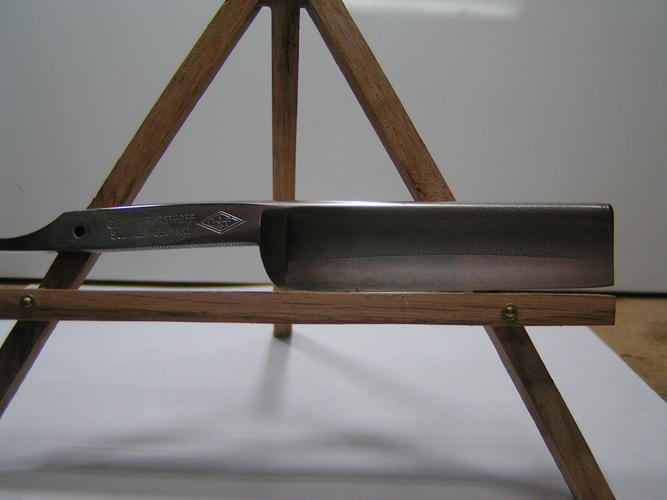
I recently tried brass as an anode. It didn't work as I had hoped. It oxidizes quickly and like copper erodes quickly. Unlike steel, the softer copper and brass seem to loose material to the process. Maybe that is why the cathode (the blade) becomes coated with the material over time. There is just so much material floating around that it catches onto the cathode and sticks. Maybe this is just a layman's attempt to identify the process falingore was trying to explain scientifically. On the other hand, although I have not verified any steel depletion, the steel simply blends into the blade and you do not see the results. Here are pictures of the brass anode and a very clear reminder of never putting your blade as the anode in an attempt to plate it.

My bellwether/Holy Grail blade has been put through so many electrolysis baths, I will be amazed if it will ever hold an edge. If I do find a solution for black rust, with the help and input from you and others, I will send it back to sharptonn to hone and see what if any damage the process has caused. I have another blade that has also been repeatedly through the process I will be sending to gssixgun for his critique of this process and how well the blade stands up to it. If the process is harming the blade, we need to know.
Randy“Tell me and I forget. Teach me and I remember. Involve me and I learn.” Ben Franklin
-
10-05-2012, 01:01 AM #66

I will be glad to hone it, Randy! It truly seems that this will not harm the blade, unless , of course, corrosion should be induced by a combination of factors. Also, Micropitting would still be an issue, if present. My interests lie with those of Glen.
I have a few with etches. Cleaned up nice. But a few spots of black always rear their heads within the etch. I have threatened to put a drop of acid in there. If this process would get that, Lubricant/wax would keep it from recurring. JMHOLast edited by sharptonn; 10-05-2012 at 01:04 AM.
-
10-05-2012, 01:25 AM #67

I whole heartily agree! At this point in time I can not even fathom this process replacing buffing! It does not remove pits (even if it did remove every spec of black rust) and can not deal with restorative matters like uneven honing. I have been careful in trying to state this as an additive process to the workshop, not a replacement. On some blades, it is all you need. For others blades, your services or knowledge of restoration is required.
Some members do not have the vast resources of equipment you have Glenn. For them, this process could be helpful. As seen by not only by my own, but other member's posts, there can be a very significant improvement in the condition of the blade. For those of us who are hand sanding, any improvement is welcomed. The members who are participating in this post have also shown that we reduced the time from hours to minutes in processing a blade.
There is still a lot of work to be done, much like your experiments with the tumbler. Did the tumbler replace buffing? No, but it has become a fixture in many razor restorer's arsenal of equipment. That is all I think this process will ever become. Just another tool for restorers.
Randy“Tell me and I forget. Teach me and I remember. Involve me and I learn.” Ben Franklin
-
10-06-2012, 02:01 AM #68
 It works!!!!!
It works!!!!!
No hallelujahs, no high five hand claps, not even a night on the town. But here is the report: electrolysis works!!! Does it remove black rust? It does! Does it go deep? It does! So why no celebration?
I have been so intent on finding the Holy Grail I have stopped documenting and simply began tinkering. Now I have to go back to square one and determine what it was that finally worked. Here is the picture:
In frames 1 and 3, the red circles indicate areas to keep an eye on. They have the heaviest black rust. Hopefully you will notice in the other frames that all black rust was removed.
In frames 2 and 4, the green circles show what appears to be black rust but is not. They are simply pitting that I can not find a way to photograph properly. Under a Jeweler's loupe, it is quite evident that the contrast is between surface metal and deeper metal. The black rust is gone!
I have put the blade into a tumbler to see if I can get a better picture of the contrast of before and after.
I also have another blade in the vat. I am using a smaller steel plate that is not raising the amperage enough to cause the charger to cycle on and off. I will report more as I learn more.
RandyLast edited by WhiteLion; 10-06-2012 at 02:05 AM.
“Tell me and I forget. Teach me and I remember. Involve me and I learn.” Ben Franklin
-
The Following User Says Thank You to WhiteLion For This Useful Post:
regularjoe (10-07-2012)
-
10-06-2012, 03:09 AM #69

This, this is a very good thing. Knowing that it works, for certain now. Finding the correct combination(s), well, we can keep doing that till we run out rusty razors. I also don't see a permanent shortage in that department.
In other news, my attempt to copper plate was unsuccessful.
It seems the additional time in the vat removed some additional rust, though not much, but did nothing more for the copper plating. I suspect that the surface of blade is not nearly clean or pure enough for a consistent plating. Fortunately, for this same reason, the plating is also very lousy and seems to come off rather easily with fine steel wool. I see to remember on the motorcycle forums that most pieces were acid bathed briefly before starting the plating process to ensure an even and thorough coating.
Tomorrow I'm going to purchase a tube of mild steel at the local hardware store. It should have a very low carbon content and a much higher iron content. I intend to set up a fencing system, much like WhiteLion showed in his earlier images, with tubing all the way around the bucket, linked with copper wire.
I'm also going to switch to a 2 liter soda bottle with the top cut off. The small diameter of the pipe means I should be able to fence six pieces of steel, one every 60 degrees, and have approximately two inches from every point of the razor to any given anode.
I'll put up pictures and some amperage numbers tomorrow.
Have a good night everyone and Randy, congratulations!Do to budget cuts the light at the end of the tunnel has been turned off; we apologize for any inconvenience.
-
10-06-2012, 11:49 PM #70

I wish I had an electron-microscope! But I don't. So the best I can do is to use my magnifying glass to try and get the best picture I am capable of at this time (yes, I am tinkering to make, not an electron-microscope, but a microscope of sorts that I can use with my camera). I hope the picture better shows the absence of black rust and that the contrast is in the pitting.
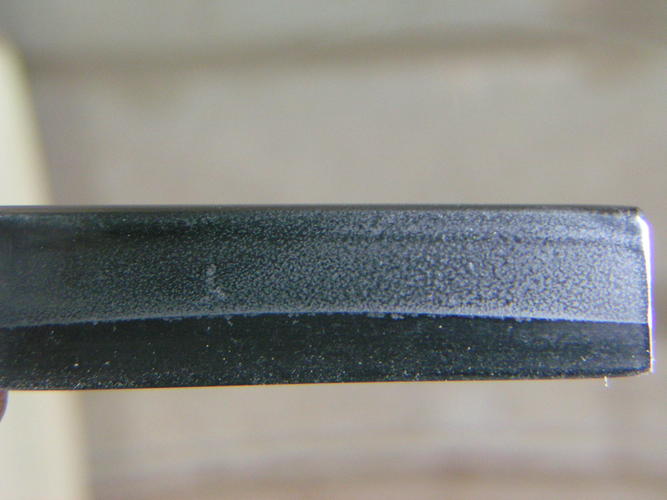
Notice on the left side where there is a shadow, it looks like black rust. But notice on the right side where there is no shadow and it is more evident that the black rust is gone.
It is hard to depict what one sees with his own eyes using photography, especially by an amateur.
As I do more research, I run into more opinions about different things. I try to post caveats as I go along. Some of them may ultimately be found to be baseless, but again, being safe is very important. The latest caveat I have to offer is this: Using baking soda, not only do you produce hydrogen but also carbon monoxide. I have also read it produces chlorine gas. None of those gases are advantageous to your health!!! I just want anyone doing experiments to proceed cautiously. I do NOT have all the answers! I am trying to share as much information as I can garner. But the information on the internet is at best confusing, contradictory and, in some cases, simply wrong. I am doing everything I can to sort between lore and fact.
I have a new bellwether/Holy Grail I am pursuing. Not a spec of brown rust, just black rust. But then again, I removed all the brown rust from blades sharptonn sent me long ago. All I have left experiment on is black rust. But then again, that really is the final result we want to accomplish - the removal of ALL rust, no matter its nature.
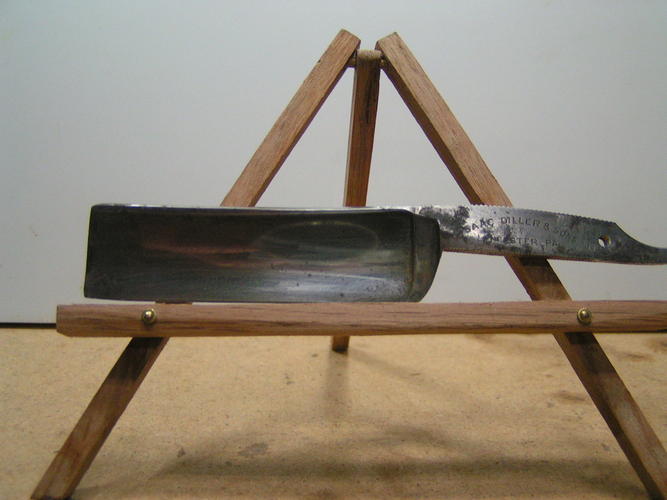
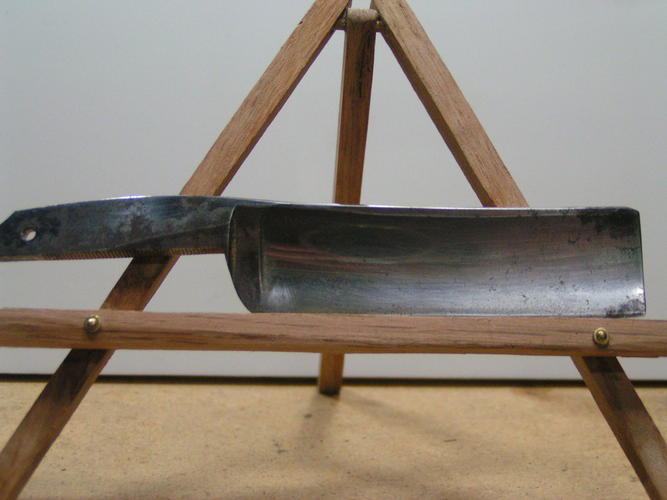
I will report more later.
Randy“Tell me and I forget. Teach me and I remember. Involve me and I learn.” Ben Franklin


 59Likes
59Likes LinkBack URL
LinkBack URL About LinkBacks
About LinkBacks







 Reply With Quote
Reply With Quote
